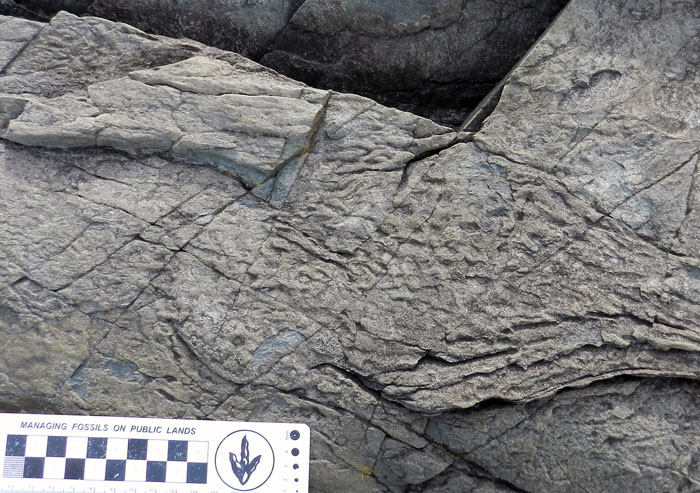In my previous post, which followed a field trip to see a spectacular assemblage of 565-million-year-old Ediacaran body and trace fossils at Mistaken Point in Newfoundland, I made an awkward confession. This admission was that the stock phrase “the present is the key to the past,” used by geologists and paleontologists to describe actualism (also known as uniformitarianism) really depends on which past you’re talking about. As it turns out, when it comes to earth history, there are a lot of pasts.
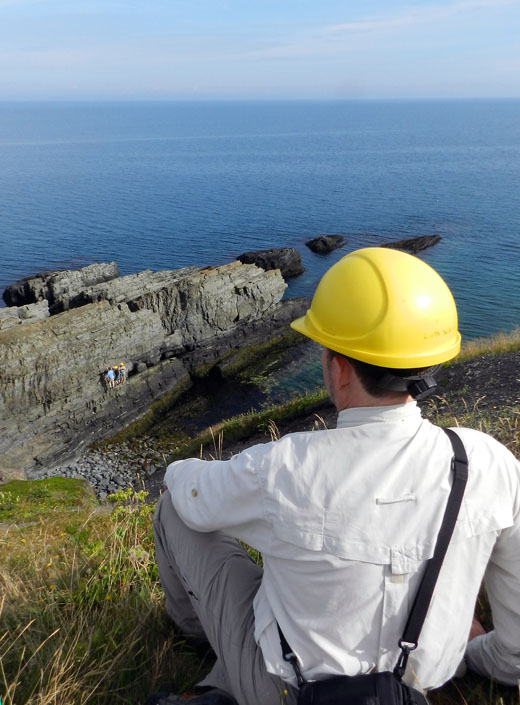 Looking from afar onto the world standard for rocks recording the transition from life that lived superficially to life that, well, went a little deeper. (Photograph by Ruth Schowalter, taken at Fortune Head, Newfoundland (Canada).)
Looking from afar onto the world standard for rocks recording the transition from life that lived superficially to life that, well, went a little deeper. (Photograph by Ruth Schowalter, taken at Fortune Head, Newfoundland (Canada).)
For instance, if you mean to apply that aphorism while referring to the last 12% of earth history, then for the most part you’ll be OK, although some of it will fall completely flat (more on that later).
But if you think it can be said blithely when referring to a time when all of the lifeforms looked like aliens from a bad Star Trek episode (TOS, of course), or when global oxygen levels were significantly lower than today, or the ozone layer protecting us from UV radiation was mostly absent, or deep-burrowing predators were completely unknown from every ecosystem, or the geochemistry of bottom sediments in the world oceans were radically different, then that’s not going to work so well for you. The world was vastly different at the Precambrian-Cambrian transition about 550 million years ago, and no amount of studying modern geological and biological processes or, say, modern traces of the Georgia barrier islands, is going to close that factual gap.
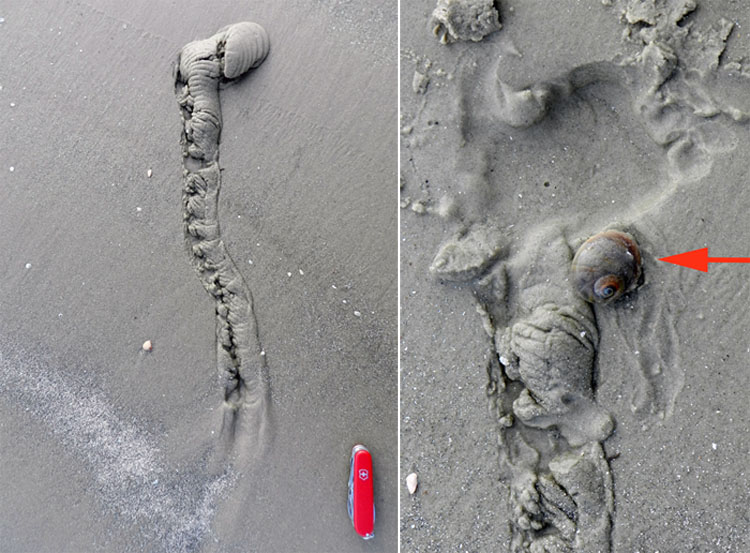 Underneath the intertidal sandflats of the Georgia barrier islands lurks the common moon snail (Neverita duplicata), detected through its burrow (left); and it radiates malevolence once exhumed from the burrow end (right, arrow). It is the top predator, the lion of the tidal flat, one might say, burrowing under sandflat surfaces to stalk its prey (other mollusks, including its own species), enveloping them with its muscular foot, and drilling into their shells to eat them alive. Simple, effective, and deadly. Was there anything like this moon snail in the Ediacaran Period, 635-542 million years ago? Nope. (Photographs by Anthony Martin, taken on Jekyll Island, Georgia.)
Underneath the intertidal sandflats of the Georgia barrier islands lurks the common moon snail (Neverita duplicata), detected through its burrow (left); and it radiates malevolence once exhumed from the burrow end (right, arrow). It is the top predator, the lion of the tidal flat, one might say, burrowing under sandflat surfaces to stalk its prey (other mollusks, including its own species), enveloping them with its muscular foot, and drilling into their shells to eat them alive. Simple, effective, and deadly. Was there anything like this moon snail in the Ediacaran Period, 635-542 million years ago? Nope. (Photographs by Anthony Martin, taken on Jekyll Island, Georgia.)
So let’s say you took a common moon snail from the Georgia coast and sent it back to the Ediacaran. You would think its evolutionarily advanced status, placed among such primitives, means that it would suddenly become the gastropod equivalent of a Terminator (the Summer Glau version, of course), wiping out every Ediacaran challenger in its mucus-lined path. Instead, it would die and quick and messy death from a combination of low oxygen levels, excessive biomats getting in its way, a lack of desirable prey, and excessive UV radiation. So you can stop building that gastropod-sized Tardis, and just face up to two realities: (1) the present is not always the key to the past; and (2) there is no such thing as time travel.
Oh yeah, back to the field trip. During the same excursion that included a stop at Mistaken Point, we also went to Fortune Head. Fortune Head is the place where the International Commission on Stratigraphy established the standard stratigraphic boundary for the switch from the Precambrian to the Cambrian. Called a Global Boundary Stratotype Section and Point (GSSP), or simply “stratotype,” this is a section of rock with the most nearly complete transition of rock units representing one time unit to the next.
 A plaque at Fortune Head Ecological Reserve, informing visitors about the scientific importance of this site to geologists and paleontologists.
A plaque at Fortune Head Ecological Reserve, informing visitors about the scientific importance of this site to geologists and paleontologists.
For example, the outcrop at Fortune Head is the stratotype for the transition from the Ediacaran Period (635-542 mya) to the Cambrian Period (542-488 mya). Sometimes geologists nickname this system of picking an exact boundary “the golden spike,” invoking images of a geologist hammering such a gaudy implement into the outcrop to imperiously announce its precise location. Lacking such geo-bling, though, we settled for one of the field trip leaders simply pointing with his walking stick to the boundary.
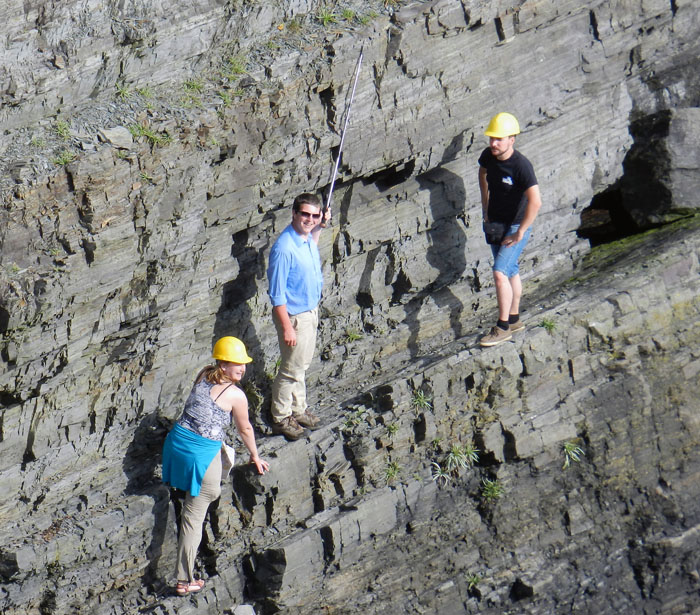 While we stayed safely on the hillside, the graduate students risked their lives to climb down onto the section and point at the Ediacaran-Cambrian boundary at Fortune Head, Newfoundland. For me, this brought back fond memories of Marlin Perkins, Jim Fowler, and Wild Kingdom. (Spoiler: the graduate students made it back OK.) (Photograph by Anthony Martin.)
While we stayed safely on the hillside, the graduate students risked their lives to climb down onto the section and point at the Ediacaran-Cambrian boundary at Fortune Head, Newfoundland. For me, this brought back fond memories of Marlin Perkins, Jim Fowler, and Wild Kingdom. (Spoiler: the graduate students made it back OK.) (Photograph by Anthony Martin.)
So how would you know for yourself where, er, when you are – geologically speaking – in a section that has the youngest rocks of the Ediacaran Period and the oldest rocks of the Cambrian Period? That’s where the awesome power of ichnology comes into play, and it’s really simple to wield. If you look at the rocks and see the following trace fossil – Treptichnus pedum – you’re in the Cambrian Period. But if you don’t, you’re in the Ediacaran.
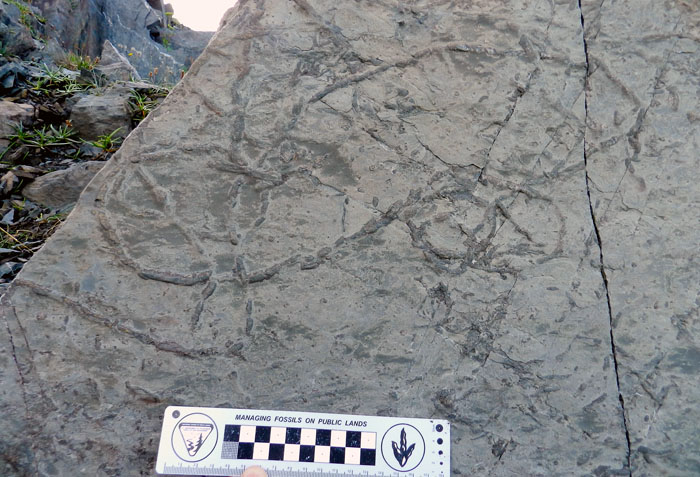 Whoa, check out that beautiful trace fossil! It’s Treptichnus pedum, a burrow made by a deposit-feeding animal, which was probably a worm-like animal, but also could have been an arthropod. Regardless of who made it, it’s a burrow reflecting a new behavior that evidently didn’t exist only a few million years before it was made. And that, boys and girls, makes this trace fossil a distinctive one. Scale in centimeters. (Photograph by Anthony Martin, taken at Grand Bank, Newfoundland.)
Whoa, check out that beautiful trace fossil! It’s Treptichnus pedum, a burrow made by a deposit-feeding animal, which was probably a worm-like animal, but also could have been an arthropod. Regardless of who made it, it’s a burrow reflecting a new behavior that evidently didn’t exist only a few million years before it was made. And that, boys and girls, makes this trace fossil a distinctive one. Scale in centimeters. (Photograph by Anthony Martin, taken at Grand Bank, Newfoundland.)
This trace fossil, a feeding burrow made by an invertebrate animal living in the seafloor 542 mya, is one of the few trace fossils used as an index fossil. Index fossils (also called guide fossils) tell you the age of the rocks you’re viewing. A good index fossil should have the following traits:
- Abundant
- Easily identifiable
- Stratigraphically restricted
- Geographically widespread
Treptichnus pedum indicates a behavior very different from every other trace fossil seen in Ediacaran rocks. It shows that the burrowing animal – probably a type of worm or arthropod – systematically probed into the sediment to ingest some of it, withdrew back into the main part of its burrow, then moved forward to probe again. Furthermore, over the course of making its burrow, its pathway may make loops, which increased the likelihood of it getting lots of goodies (organics) from the sediment. This behavior was totally different, and if it had been allowed to happen in the Ediacaran, no doubt would have led to laughter and ostracizing by other epifaunal and infaunal invertebrates. That is, if they could laugh or ostracize. (Hey, like I said, it was really different back then.)
But here’s the really strange dimension of the Ediacaran Period: as far as burrowers were concerned, it was mostly two-dimensional. Animal movement seemed restricted to horizontal planes, in which animals (worm-like or otherwise) squirmed, crawled, anchored and pulled, or whatever they did to get around, but stayed mainly in the plane.
Vertical movement, such as daring to burrow up or down in the sediment, was forbidden by either the rules of the marine ecosystems at that time, or by the bodies of the animals themselves. What kept animals from digging a little deeper? Part of the problem was that the seafloor was ruled by microbial mats, which covered sediment surfaces like plastic coverings on furniture at your grandma’s home.
This wrinkled surface on a Lower Cambrian sandstone just above the Ediacaran-Cambrian boundary at Fortune Head, Newfoundland is evidence of a probable microbial mat, or “biomat” These biomats were really common in the Ediacaran, became less common in the Cambrian, then after the Cambrian became more rare than a modest politician in an election year. Scale in centimeters. (Photograph by Anthony Martin.)
So if you were an animal then, you had no choice: you could adapt to being under these mats or on top of them. To make matters worse, all animal life apparently lacked the right hard parts, limbs, or other anatomical traits that could have pierced those mats or excavated the sediment underneath them. So no amount of rugged individualism in those invertebrates was going to change their horizontal movement to vertical.
A horizontal trail, probably made by an invertebrate animal, preserved on a 565-million-year-old bedding plane at Mistaken Point, Newfoundland. So you thought you could burrow vertically? Forget it, Jake – it’s Ediacaratown!
Of course, eventually the earth changed, the tyranny of the microbial mats was overcome by new evolutionary innovations in animals, and other adaptive paths took life into a third dimension. Consequently, the animals living on the seafloor started acting more like the ones we see today: not just living on or just underneath that seafloor, but also going down into it. This change was huge in an ecological sense, sometimes dubbed by paleontologists as the agronomic revolution, which accompanied the Cambrian explosion. This is not to say that revolutions must involve explosions, though. On the contrary, this was a quiet and slow sort of revolt, in which as earth environments changed, natural selection favored the burrowers, and the burrowers changed their environment. ¡Viva la revolución!
Here’s a little musical lesson about the increased biodiversity of the Cambrian Period. Professors, assign it to your students. Students, tell you professors about it, so they can look like they’re almost hip when they assign it. And for American viewers: the song has some sort of subversive subliminal message toward the end, praising some country other than the U.S. You’ve been warned.
In this respect, what was most meaningful about our visit to Fortune Head was seeing evidence of this ecological shift at the very same outcrop holding the stratotype for the Ediacaran-Cambrian boundary. Small, thin burrows preserved in the rocks from the earliest part of the Cambrian Period, spoke of this difference in the way life related to the seafloor. Vertically oriented they were, having gone into the sediment at a depth only the width of my fingernail. Nonetheless, it was a start, and an important one, heralding the evolution of ecosystems that more closely approach those of today.
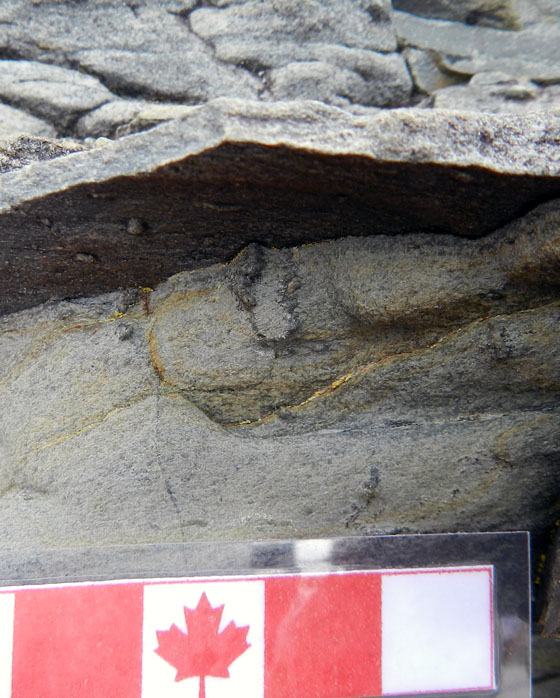 See that little U-shaped burrow just below that thin sandstone? It only goes about a centimeter down, but that’s deeper than nearly any other burrow you would see in rocks from the Ediacaran Period. This sort of simple U-shaped burrow is given the ichnogenus name Arenicolites by ichnologists. Canadian-themed scale is in centimeters. (Photograph by Anthony Martin, taken at Fortune Head, Newfoundland.)
See that little U-shaped burrow just below that thin sandstone? It only goes about a centimeter down, but that’s deeper than nearly any other burrow you would see in rocks from the Ediacaran Period. This sort of simple U-shaped burrow is given the ichnogenus name Arenicolites by ichnologists. Canadian-themed scale is in centimeters. (Photograph by Anthony Martin, taken at Fortune Head, Newfoundland.)
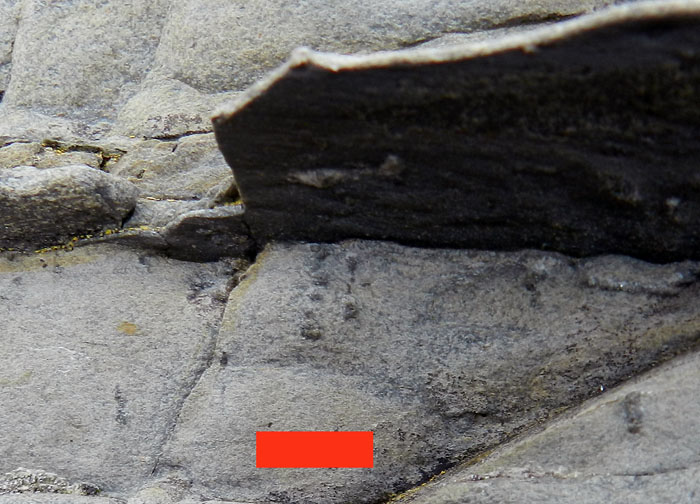 Same goes for this burrow, which is a spiral – cut on its side – and named Gyrolithes. Scale bar = 1 cm (0.4 in). (Photograph by Anthony Martin, taken at Fortune Head, Newfoundland.)
Same goes for this burrow, which is a spiral – cut on its side – and named Gyrolithes. Scale bar = 1 cm (0.4 in). (Photograph by Anthony Martin, taken at Fortune Head, Newfoundland.)
Life has moved further downward since, from worms to arthropods in marine environments, then later from millipedes to dinosaurs to gopher tortoises in continental environments, looking to places well below the surface that they could call home. So it was a awe-inspiring privilege to see a sample from the geologic record of when this first started, one centimeter at a time.
What was next stage for burrowing animals in the world’s oceans during the next 100 million years or so? To answer that question, we’ll jump ahead to the Ordovician Period, shuttling between rocks and trace fossils of that age in both Newfoundland and Georgia (USA, y’all). But while doing this, we’ll also look for glimpses of how these Ordovician trace fossils get just a little bit closer to the traces we being made in the modern sediments of the Georgia coast, and thus more like the actualism we all know and love.
Further Reading
Bottjer,D.J., Hagadorn, J.W., and Dornbos, S.Q. 2000. The Cambrian substrate revolution. GSA Today, 10(9): 1-7.
Canfield, D.E., and Farquhar, J. 2009. Animal evolution, bioturbation, and the sulfate concentration of the oceans. Proceedings of the National Academy of Sciences, 106: 8123-8127.
Gingras, M., et al. 2011. Possible evolution of mobile animals in association with microbial mats. Nature Geoscience, 4: 372-375.
Seilacher, A. 1999.Biomat-related lifestyles in the Precambrian. Palaios, 14: 86-93.
Vickers-Rich, P., and Komarower, P. (editors). 2007 The Rise and Fall of the Ediacaran Biota. Geological Society of London, Special Publication 286: 448 p.

